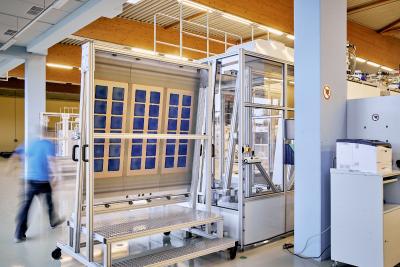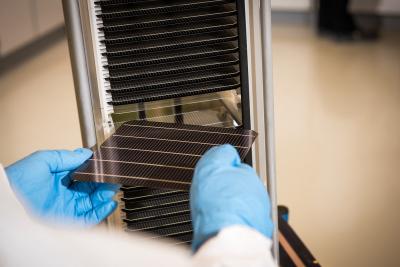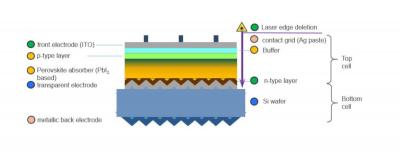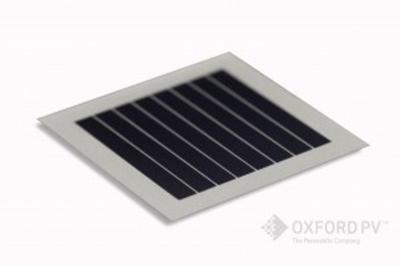 Oxford Photovoltaics Limited (Oxford PV) was founded in 2010 as a spin-out from the University of Oxford to commercialize a new technology for thin-film solar cells. It was amongst the first in the world to recognize the potential of perovskites to act as a low-cost, highly efficient solar cell absorber material to convert sunlight into electricity.
Oxford Photovoltaics Limited (Oxford PV) was founded in 2010 as a spin-out from the University of Oxford to commercialize a new technology for thin-film solar cells. It was amongst the first in the world to recognize the potential of perovskites to act as a low-cost, highly efficient solar cell absorber material to convert sunlight into electricity.
Oxford PV is developing and commercializing thin-film perovskite solar cells, which can be printed directly onto silicon solar cells, CIGS solar cells or glass. Pioneering work developing perovskite thin-film solar cells has delivered a route to boosting the efficiency of current commercial cells; using a high efficiency coating in a multi-junction or “tandem†cell architecture. In addition, printing perovskites directly onto glass has led to a semi-transparent coating ideal for BIPV applications and, once integrated into the glazing units of a building, the technology is capable of providing a significant percentage of the building’s electrical energy requirements directly from sunlight.
By employing well known and well understood printing processes, focused on inexpensive and abundant raw materials, Oxford PV has developed a highly cost effective technology.
The company has exclusively licensed the rapidly growing portfolio of fundamental intellectual property developed by its academic team.
Oxford PV has acquired the former thin-film production site of Bosch Solar in Germany, to establish a fab with pilot-scale capacity for perovskite wafers. To that end, the Company also received funding of €15 million form the European Investment Bank (EIB), to support the commercialization of its perovskite-on-silicon tandem solar cell technology. In June 2018, Oxford PV reported a new perovskite tandem solar cell record, certified by Fraunhofer ISE at a conversion efficiency of 27.3%. Oxford PV’s latest record for a 1 cm2 perovskite-silicon tandem solar, reportedly exceeds the former 26.7% efficiency world record for a single-junction silicon solar cell.
Unit 7-8 Oxford Industrial Park Mead Road
Oxford
OX5 1QU
United Kingdom
The latest Oxford PV news:
Meyer Burger still developing new perovskite solar technologies and is looking for more collaboration projects
Solar panel developer and producer Meyer Burger says it is pursuing new research projects on the industrialization of perovskite solar cells. The company is aiming to partner with research institutes worldwide for perovskite technologies.

Meyer Burger also updated that an "extensive industrial research project" is already underway with the Fraunhofer Institute in Germany.
Meyer Burger is considering legal options to enforce its rights after Oxford PV announces unilateral termination of the collaboration
Earlier this month, Oxford PV announced the completion of the build-out of its manufacturing site in Brandenburg an der Havel, Germany. Oxford PV concluded that announcement by saying that "With the achievement of this factory milestone, Oxford PV has terminated its exclusive relationship with Meyer Burger".
Meyer Burger Technology was informed of the termination of partnership (in place since 2019) through the press release (as well as a letter from Oxford Photovoltaics). In view of the unexpected announcement of termination by Oxford PV, Meyer Burger is reportedly considering legal options to enforce its rights.
Oxford PV completes build-out of its Brandenburg factory
Oxford PV has announced that it has completed the build-out of its manufacturing site in Brandenburg an der Havel, Germany.

The site houses the world's first volume manufacturing line for Oxford PV's innovative perovskite-on-silicon tandem solar cells with an annual target manufacturing capacity of 100 MW. Oxford PV expects the line to start full production in 2022.
Oxford PV hits new perovskite-silicon tandem world record
Oxford PV has reached a new efficiency world record for perovskite-silicon tandem cells at 29.52%, passing the previous record set less than a year ago by Helmholtz Zentrum Berlin. The new record has been certified by the U.S. National Renewable Energy Laboratory.

The new record was achieved on a cell measuring 1.12cm2, produced in a laboratory setting. Oxford PV previously held the tandem cell efficiency record at 27.3%, and then 28%, before a group at Helmholtz Zentrum Berlin (HZB) pushed the record to 29.15% in January 2020. Both Oxford PV and HZB have stated that they have clear roadmaps to push this record beyond 30% in the near future.
Oxford PV’s new manufacturing facility backed with €8.8 million funding
Oxford PV, currently involved in building a manufacturing facility in Brandenburg an der Havel for its silicon perovskite tandem solar cells (in which it is investing around â¬44 million), has received â¬8.8 million funding from the state Ministry of Economics in Potsdam for this project.
'I am delighted that Oxford Photovoltaics has brought the solar technology developed by the company itself to market maturity and that it will soon start with industrial series production here in Brandenburg,' said Brandenburg Minister for Economic Affairs Jörg Steinbach. 'The decision by Oxford PV to expand the production facility in Hohenstücke is a clear commitment to our community.'
Oxford PV declares perovskite solar cells on the market within a year
Oxford PV's Professor Henry Snaith recently stated that the Company's perovskite-based solar cells are scheduled to go on sale next year.
Professor Snaith said: "Perovskite PV has demonstrated its immense opportunity to transform solar energy generation... I am especially looking forward to the next 12 months and seeing our first commercial perovskite-silicon solar product on the market."
Oxford PV hopes to deliver perovskite-silicon tandem solar cells within a year
Oxford PV recently stated that it hopes to deliver perovskite-silicon tandem solar cells to high end solar module manufacturers in the first half of 2021, now less than a year away.

The group expects these solar cells to have an efficiency between 26-27%, to increase in efficiency by 1% per year as the company improves its manufacturing techniques. It was said that initially, a 400 watt 60-cell solar module will probably be available.
Oxford PV places $18.2 million order with Meyer Burger for production line expansion
 After ordering a 100 MW HJT production line from Meyer Burger in August 2019, Oxford PV has placed another partial order to expand the HJT line to an integrated 125 MW production line for high-efficiency perovskite HJT tandem cells.
After ordering a 100 MW HJT production line from Meyer Burger in August 2019, Oxford PV has placed another partial order to expand the HJT line to an integrated 125 MW production line for high-efficiency perovskite HJT tandem cells.
The Swiss solar PV equipment manufacturer Meyer Burger Technology has received this partial order, worth CHF 18 million ($18.2 million).
Oxford PV makes strides towards PSC commercialization with new $20.5 million PV production line
After forming a strategic partnership in March 2019 between Meyer Burger and Oxford Photovoltaics, Meyer Burger has announced that it has received its first order from Oxford Photovoltaics (Oxford PV), for a heterojunction (HJT) manufacturing line including necessary adaptions enabling the upgrade to perovskite-on-HJT tandem technology.

The order for the upgrade itself will reportedly follow later this year. The current contract volume is about CHF 20 million and provides Oxford PV with an initial manufacturing capacity of 100 MW with plans to expand tandem solar cell production capacity to 250 MW by the end of 2020.
Oxford PV closes £65 million funding round
 Oxford PV recently announced it has closed its Series D funding round. An additional £34 million, following the £31 million first close, brings the funding round total to £65 million.
Oxford PV recently announced it has closed its Series D funding round. An additional £34 million, following the £31 million first close, brings the funding round total to £65 million.
The first close, announced in March 2019, included a significant new investment from Goldwind, the leading provider of integrated renewable energy solutions in China, as well as investment from existing shareholders including Equinor and Legal & General Capital. The additional funds include the major new investment from Meyer Burger, the leading photovoltaic equipment supplier, announced in March 2019, with the remaining investment coming from other new and existing investors.
Pagination
- Previous page
- Page 2
- Next page

